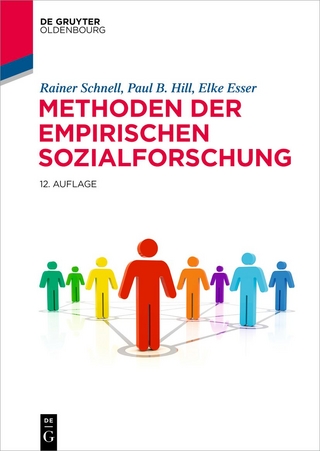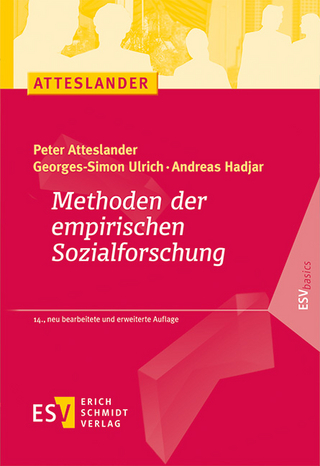
Presenting Statistical Results Effectively
SAGE Publications Ltd (Verlag)
978-1-4462-6980-0 (ISBN)
Perfect for any statistics student or researcher, this book offers hands-on guidance on how to interpret and discuss your results in a way that not only gives them meaning, but also achieves maximum impact on your target audience. No matter what variables your data involves, it offers a roadmap for analysis and presentation that can be extended to other models and contexts.
Focused on best practices for building statistical models and effectively communicating their results, this book helps you:
- Find the right analytic and presentation techniques for your type of data
- Understand the cognitive processes involved in decoding information
- Assess distributions and relationships among variables
- Know when and how to choose tables or graphs
- Build, compare, and present results for linear and non-linear models
- Work with univariate, bivariate, and multivariate distributions
- Communicate the processes involved in and importance of your results.
Robert Andersen is Professor of Business, Economics and Public Policy, and Professor of Strategy at the Ivey Business School, Western Univeristy. He is also cross-appointed in the Departments of Sociology, Political Science, and Statistics and Actuarial Science. His previous appointments include Distinguished Professor of Social Science at the University of Toronto, Senator William McMaster Chair in Political Sociology at McMaster University, and Senior Research Fellow at the University of Oxford. Andersen’s research expertise is in social statistics, social stratification, and political economy. Much of his recent research has explored the cross-national relationships between economic conditions, especially income inequality, and a wide array of attitudes and behaviours important for liberal democracy and a successful business environment, including social trust, tolerance, civic participation, support for democracy and attitudes toward public policy. His published research includes Modern Methods for Robust Regression (Sage, 2008), and more than 70 academic papers including articles in the Annual Review of Sociology, American Journal of Political Science, American Sociological Review, British Journal of Political Science, British Journal of Sociology, Journal of Politics, Journal of the Royal Statistical Society, and Sociological Methodology. Andersen has provided consulting for the United Nations, the European Commission, the Canadian Government and the Council of Ministers of Education, Canada. Dave Armstrong is the Canada Research Chair in Political Methodology and Associate Professor of Political Science at Western University and is cross-appointed in the Department of Statistics and Actuarial Sciences. Professor Armstrong earned a Ph.D. in Government and Politics from the University of Maryland in 2009. Prior to arriving at Western, he had a post-doctoral position at Oxford University after which he taught in the Political Science department at the University of Wisconsin-Milwaukee. He has been a faculty member at the Inter-university Consortium for Political and Social Research Summer Program at the University of Michigan since 2006 and has taught multiple courses at the Essex Summer School in Social Science Data Analysis at the University of Essex and the Oxford University Spring School in Quantitative Methods for Social Research. His current work focuses on the use of non-parametric models in conventional social scientific inference. His work has been published in such journals as The American Political Science Review, The American Journal of Political Science, The American Sociological Review, The Annual Review of Political Science, The Journal of Peace Research, The Canadian Journal of Political Science and The R Journal. His most recent book is Analyzing Spatial Models of Choice and Judgement with R, with Ryan Bakker, Royce Carroll, Chris Hare, Keith Poole and Howard Rosenthal (2nd ed. 2021)
Chapter 1: Some Foundation
What is a ‘Model’?
Statistical Inference
Part A: General Principles of Effective Presentation
Chapter 2: Best Practices for Graphs and Tables
When to use Tables and Graphs
Constructing Effective Tables
Constructing Clear and Informative Graphs
Chapter 3: Methods for Visualizing Distributions
Displaying the Distributions of Categorical Variables
Displaying Distributions of Quantitative Variables
Transformations
Chapter 4: Exploring and Describing Relationships
Two Categorical Variables
Categorical Explanatory Variable and Quantitative Dependent Variable
Two quantitative Variables
Multivariate Displays
Part B: The Linear Model
Chapter 5: The Linear Regression Model
Ordinary Least Squares Regression
Hypothesis tests and confidence intervals
Assessing and Comparing Model Fit
Relative Importance of Predictors
Interpreting and presenting OLS models: Some empirical examples
Linear Probability Model
Chapter 6: Assessing the Impact and Importance of Multi-category Explanatory Variables
Coding Multi-category Explanatory Variables
Revisiting Statistical Significance: Multi-category Predictors
Relative importance of sets of regressors
Graphical Presentation of Additive Effects
Chapter 7: Identifying and Handling Problems in Linear Models
Nonlinearity
Influential Observations
Heteroskedasticity
Nonnormality
Chapter 8: Modelling and Presentation of Curvilinear Effects
Curvilinearity in the Linear Model Framework
Nonlinear Transformations
Polynomial Regression
Regression Splines
Nonparametric Regression
Generalized Additive Models
Chapter 9: Interaction Effects in Linear Models
Understanding Interaction Effects
Interactions Between Two Categorical Variables
Interactions Between One Categorical Variable and One Quantitative Variable
Interactions Between Two Continuous Variables
Interaction Effects: Some Cautions and Recommendations
Part C: The Generalized Linear Model and Extensions
Chapter 10: Generalized Linear Models
Basics of the Generalized Linear Model
Maximum Likelihood Estimation
Hypothesis tests and confidence intervals
Assessing Model Fit
Empirical Example: Using Poisson Regression to Predict Counts
Understanding Effects of Variables
Measuring Variable Importance
Model Diagnostics
Chapter 11: Categorical Dependent Variables
Regression Models for Binary Outcomes
Interpreting Effects in Logit and Probit Models
Model Fit for Binary Regression Models
Diagnostics Specific to Binary Regression Models
Extending the Binary Regression Model – Ordered and Multinomial Models
Chapter 12: Conclusions and Recommendations
Choosing the Right Estimator
Research Design and Measurement Issues
Evaluating the Model
Effective Presentation of Results
| Erscheint lt. Verlag | 14.1.2022 |
|---|---|
| Verlagsort | London |
| Sprache | englisch |
| Maße | 189 x 246 mm |
| Gewicht | 1030 g |
| Themenwelt | Sozialwissenschaften ► Soziologie ► Empirische Sozialforschung |
| ISBN-10 | 1-4462-6980-9 / 1446269809 |
| ISBN-13 | 978-1-4462-6980-0 / 9781446269800 |
| Zustand | Neuware |
| Haben Sie eine Frage zum Produkt? |
aus dem Bereich


